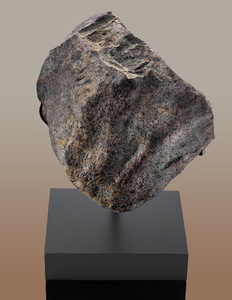Deep Impact: Martian, Lunar and other Rare Meteorites
The dappled patina of this massive stone meteorite ranges from tan to milk chocolate. Patches of fusion crust, an artifact of frictional heating while plunging through Earth’s atmosphere, are in evidence. Veins of impact melt are seen at the top and shallow regmaglypts — yet another artifact of its fiery plunge to Earth — are visible on the reverse. Accompanied by a custom armature.
241 x 218 x 189 mm. (9½x 8½x 7½ in..) and 16.38 kg. (36 lbs)
A superior example of a large chondritic meteorite, from the asteroid belt between Mars and Jupiter. Meteorites possess highly specific elemental signatures, not only in regard to their constituent elements but also the ratios of these elements. Based on the foregoing, XRF analysis indisputably confirms this is a meteorite, but such analysis does not provide the complete picture. The type of meteorite is not fully known until a research sample is removed for analysis. To enable scientists to refer to individual meteorites and their characteristics, there must be a nomenclature system. In the desert, where there are few distinguishing geological features for which meteorites are frequently named, meteorites are instead named after a designated grid in which they were found followed by a consecutive number. As the current offering was found in the Sahara Desert, it would be assigned a name that commences “Northwest Africa” (NWA) followed by a number that today would be in the 12,000s. For this to be “named”, a 20-gram (or larger) sample must be sent to an accredited scientist for analysis. The researcher’s findings are then peer reviewed and upon a consensus of the specimen’s petrography, geochemistry, type and classification, the meteorite is then named and published in the Meteoritical Bulletin and is then part of the scientific literature. Should one wish to have this meteorite classified and be listed in the annals of the Meteoritical Bulletin — or one can be anonymous if preferred — we can provide the introduction and guide you through this process.
Christie's would like to thank Dr. Alan E. Rubin at the Institute of Geophysics and Planetary Physics, University of California, Los Angeles for his assistance in preparing this catalog note.
View it on
Estimate
Time
Auction House
The dappled patina of this massive stone meteorite ranges from tan to milk chocolate. Patches of fusion crust, an artifact of frictional heating while plunging through Earth’s atmosphere, are in evidence. Veins of impact melt are seen at the top and shallow regmaglypts — yet another artifact of its fiery plunge to Earth — are visible on the reverse. Accompanied by a custom armature.
241 x 218 x 189 mm. (9½x 8½x 7½ in..) and 16.38 kg. (36 lbs)
A superior example of a large chondritic meteorite, from the asteroid belt between Mars and Jupiter. Meteorites possess highly specific elemental signatures, not only in regard to their constituent elements but also the ratios of these elements. Based on the foregoing, XRF analysis indisputably confirms this is a meteorite, but such analysis does not provide the complete picture. The type of meteorite is not fully known until a research sample is removed for analysis. To enable scientists to refer to individual meteorites and their characteristics, there must be a nomenclature system. In the desert, where there are few distinguishing geological features for which meteorites are frequently named, meteorites are instead named after a designated grid in which they were found followed by a consecutive number. As the current offering was found in the Sahara Desert, it would be assigned a name that commences “Northwest Africa” (NWA) followed by a number that today would be in the 12,000s. For this to be “named”, a 20-gram (or larger) sample must be sent to an accredited scientist for analysis. The researcher’s findings are then peer reviewed and upon a consensus of the specimen’s petrography, geochemistry, type and classification, the meteorite is then named and published in the Meteoritical Bulletin and is then part of the scientific literature. Should one wish to have this meteorite classified and be listed in the annals of the Meteoritical Bulletin — or one can be anonymous if preferred — we can provide the introduction and guide you through this process.
Christie's would like to thank Dr. Alan E. Rubin at the Institute of Geophysics and Planetary Physics, University of California, Los Angeles for his assistance in preparing this catalog note.



